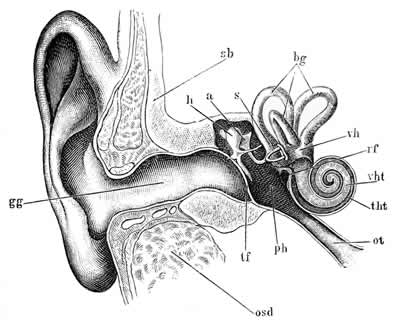Scientists discover novel pain sensors in inner ear that warn of dangerously loud noise.
Our hearing has a secret bodyguard, a newly discovered connection from the cochlea to the brain that warns of intense incoming noise that causes tissue damage and hearing loss, according to new research by Northwestern Medicine scientists.
Scientists believe they have discovered the ear’s own novel pain system that protects it from very loud or damaging noise. It may be the reason you jam your fingers in your ears when a fire engine or ambulance wails close by. The nerves that normally alert you to pain — like touching a hot burner on a stove — are not present in your inner ear. So, it needs its own private alert system.
The discovery may provide insight into the cause and treatment for such painful hearing conditions as hyperacusis, an oversensitivity and earache in response to everyday sounds, common in soldiers exposed to explosives in the military, and tinnitus, a persistent and uncomfortable ringing in the ears.
The pathway, which scientists named auditory nociception (pain), is different from the one that transfers information about sound to the brain and enables you to hear a bird singing or a friend gossiping. This pathway is populated by a single set of neurons activated only by noxious or dangerous levels of noise. Scientists aren’t sure if the neurons are triggered by the death of hair cells (which detect normal level sound as part of hearing) or simply dangerous sound levels.

“It’s very important for your system to have protection from damaging sound,” said study senior author Jaime García-Añoveros, associate professor of anesthesiology at Northwestern University Feinberg School of Medicine. “When sensory hair cells in the ear die, they are not repopulated. That’s why hearing loss is irreversible. You need to be able to detect dangerous sound the way your nerve cells alert you to the danger of putting your hand on a hot iron.”
García-Añoveros also is an investigator at Northwestern’s Knowles Hearing Center and a member of the Robert H. Lurie Comprehensive Cancer Center of Northwestern University.
The study will be highlighted Feb. 20 in Nature Reviews Neuroscience and was recently published in Current Biology. The research was conducted with mice, and García-Añoveros believes the pathway has an equivalent in humans. Next, he wants to research the human pathway.
Hearing loss is the most common degenerative condition in humans, because we are exposed to noise throughout our lives and are living longer, García-Añoveros said.
The discovery offers an entirely new way of looking at the painful and intractable hearing conditions hyperacusis and tinnitus.
“We do not know how to treat these debilitating conditions, and understanding what neuronal pathway might be involved is essential, ” García-Añoveros said. “If we find they are actually pain syndromes rather than hearing syndromes, perhaps they could be treated effectively with analgesic pain medication that acts on the brain.”
“We think the pain these patients feel may be from a dysfunction in this inner ear pain system and similar to neuropathic pain,” García-Añoveros said.
The pain system could trigger a protective autonomic reflex such as stiffening the inner ear muscles to reduce the level of sound entering the ear, García-Añoveros said. Or, it might cause a sensation of pain that causes you to plug your fingers in your ears when you’re exposed to a jackhammer on a street corner.
Next, Northwestern scientists want to learn what parts of the brain are involved in this sensation. They want to use brain imaging to see if pain areas are activated in the brain when ears are exposed to loud noises.
Other Northwestern authors on the study include Emma N. Flores, Anne Duggan, Thomas Madathany, Ann K. Hogan, Freddie G. Márquez and Gagan Kumar.
The study was funded by grants R21DC006089 and F31DC012013 from the National Institute of Deafness and Other Communication Disorders and R01NS044363 from the National Institute of Neurological Disorders and Stroke, all of the National Institutes of Health, and N00014-14-1-0709 from the Office of Naval Research.
Contact: Marla Paul – Northwestern University
Source: Northwestern University press release
Image Source: The image is credited to Morten Bisgaard, and is from the book “Tidens Naturlaere” by Poul la Cour, circa 1903. The image is in the public domain
Original Research: The research will appear in the February 20 2015 edition of Nature Reviews Neuroscience. We will provide a link to the research when it becomes available to the public.
Abstract for “A Non-canonical Pathway from Cochlea to Brain Signals Tissue-Damaging Noise” by Emma N. Flores, Anne Duggan, Thomas Madathany, Ann K. Hogan, Freddie G. Márquez, Gagan Kumar, Rebecca P. Seal, Robert H. Edwards, M. Charles Liberman, and Jaime García-Añoveros in Current Biology. Published online January 19 2015 doi:10.1016/j.cub.2015.01.009







